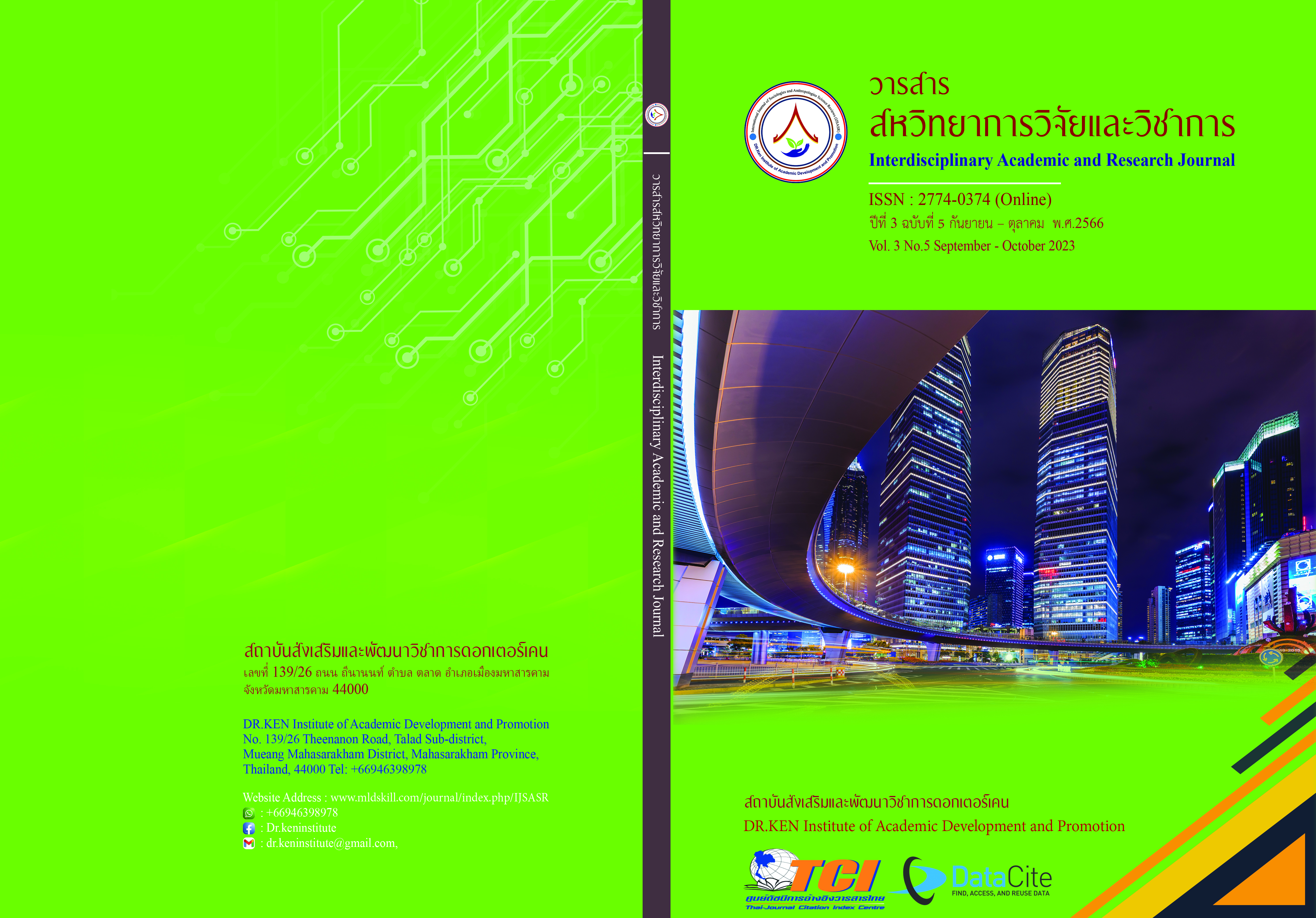Analytical Thinking and Academic Achievement in Biology on Chromosomes and Genetic Material of Mathayomsuksa 4 students receiving Cooperative Learning Management in STAD format together with Concept Map
DOI:
https://doi.org/10.14456/iarj.2023.264Keywords:
STAD; , Concept map; , Analytical Thinking;Abstract
Changes in social, economic, environmental, and political conditions in the 21st century are happening rapidly. cause awareness in developing the potential of each country, which the design and arrangement of Learning that is right for students in the 21st century is critical. Therefore, the purposes of this research were; 1) to compare the analytical thinking of grade 10 students before and after the STAD cooperative learning management together with the concept map. 2) to compare the Learning Achievement on Chromosomes and Genetic Material of grade 10 students after the STAD cooperative learning management together with concept map and the 70 percent criteria the sample group consisted of twenty-nine Mathayomsuksa 4 students in the second semester of the academic year 2022 at Chaturaphak Phiman Ratchadaphisek School, Hua Chang Subdistrict, Chaturaphak Phiman District, Roi Et Province from cluster random sampling, using the classroom as the random unit. The research tools were STAD cooperative learning management together with a concept map of 6 plans 12 hours (the most appropriate level, analytical thinking test multiple-choice, 20 items the difficulty (p) 0.22 - 0.59, the discrimination 0.07 - 0.44, and the confidence value 0.52 and academic achievement test multiple-choice, 20 items the difficulty (p) 0.22 - 0.47 and the discriminating power 0.44 - 1.00. The data analysis statistics were mean and standard deviation. Statistics used to test hypotheses were a t-test for the dependent sample and a t-test for one sample. The research found that (1) post-learning analytical thinking using STAD cooperative learning management together with concept map on chromosomes and genetic material. of Mathayomsuksa 4 students had an average score of analytical thinking after learning 10.44, S.D = 2.69, higher than the average before learning to 8.75, S.D. = 2.83, Sig. = .000. (2) The learning achievement of students who used STAD cooperative learning management together with concept maps. There was a mean score of achievement after learning of 14.20, S.D. = 2.39, Sig. = .646 It can be concluded that the students who were managed by the cooperative learning management method STAD together with the concept map. had post-learning achievement not different from the 70% criterion with a statistical significance at the .05 level.
References
ชมพูสัจจาวาณิชย์. (2553). ผลการจัดการเรียนรู้แบบกลุ่มร่วมมือเทคนิค STAD โดยชุดการเรียน เรื่อง บรรยากาศ กลุ่มสาระการเรียนรู้วิทยาศาสตร์ สำหรับนักเรียนชั้นมัธยมศึกษาปีที่ 1. วิทยานิพนธ์ ค.ม. มหาสารคาม: มหาวิทยาลัยราชภัฏมหาสารคาม
ทิศนา แขมมณี. (2552). รูปแบบการเรียนการสอน. กรุงเทพฯ: สำนักพิมพ์แห่งจุฬาลงกรณ์มหาวิทยาลัย.
ทิศนา แขมมณีและ คณะ. (2544). วิทยาการด้านการคิด. กรุงเทพฯ : สถาบันพัฒนาคุณภาพวิชาการ.
ธัญญา ผลอนันต์ และขวัญฤดี ผลอนันต์. (2543). แบบฝึกหัดคิดพิชิต มายด์แม็ป สำหรับผู้บริหาร หัวหน้างาน และพนักงาน. กรุงเทพฯ: ขวัญข้าว.
ประพันธ์ศิริ สุเสารัจ. (2551). การพัฒนาการคิด. กรุงเทพฯ: โรงพิมพ์ห้างหุ้นส่วนจำกัด 9119 เทคนิคพริ้นติ้ง.
ไพศาล วรคำ. (2561). การวิจัยทางการศึกษา. พิมพ์ครั้งที่ 9. มหาสารคาม: ตักสิลาการพิมพ์.
มานัส จันทร์อยู่. (2556). ผลการจัดกิจกกรมการเรียนรู้วิชาชีววิทยา ชั้นมัธยมศึกษาปีที่ 5 เรื่อง การสังเคราะห์ด้วยแสงของพืชด้วยกลุ่มร่วมมือเทคนิค STAD. วิทยานิพนธ์ปริญญาการศึกษามหาบัณฑิต: มหาวิทยาลัยมหาสารคาม
รวงทอง เปลี่ยนเอก. (2560). การพัฒนาชุดการเรียนการสอนโดยใช้การเรียนรูแบบร่วมมือ แบบแบ่งปะนความสำเร็จร่วมกับหนังสืออิเล็กทรอนิกส์ สาระเพิ่มเติมวิชาชีววิทยา หน่วยการเรียนรู้ เรื่องยีนและโครโมโซม ชั้นมัธยมศึกษาปีที่ 6. วิทยานิพนธ์ปริญญามหาบัณฑิต: มหาวิทยาลัยราชภัฏสกลนคร.
รัตนา สิงห์กูล. (2550). ผลการสอดแทรกกิจกรรมฝึกทักษะการคิดพื้นฐานในการเรียนการสอนที่มีต่อความสามารถในการเรียนการสอนที่มีต่อความสามารถในการคิดวิเคราะห์ของนักเรียนชั้นประถมศึกษาปีที่ 1. วิทยานิพนธ์ปริญญามหาบัณฑิต : บัณฑิตวิทยาลัยมหาวิทยาลัยราชภัฏลำปาง.
ฤดีรัตน์ สาระบุตร, สิทธิศักดิ์ จุลศิริพงษ์ และวาสนา กีรติจำเริญ. (2557). ผลสัมฤทธิ์ทางการเรียนทักษะกระบวนการทางวิทยาศาสตร์และจิตวิทยาศาสตร์ ของนักเรียนชั้นมัธยมศึกษาปีที่ 5 จากการจัดการเรียนรู้แบบสืบเสาะหาความรู้ 7 ขั้น. วิทยานิพนธ์ปริญญาการศึกษามหาบัณฑิต: มหาวิทยาลัยราชภัฏนครราชสีมา.
วัชรา เล่าเรียนดี และคณะ. (2560). กลยุทธ์การจัดการเรียนรู้เชิงรุกเพื่อพัฒนาการคิดและยกระดับคุณภาพการศึกษาสำหรับศตวรรษที่ 21. นครปฐม : เพชรเกษมพริ้นติ้ง กรุ๊ป.
สถาบันทดสอบทางการศึกษาแห่งชาติ. (2563). รายงานผลการทดสอบทางการศึกษาระดับชาติขั้นพื้นฐาน (O-NET) ชั้นมัธยมศึกษาปีที่ 6. กรุงเทพฯ: สถาบันทดสอบทางการศึกษาแห่งชาติ (องค์การมหาชน).
สถาบันทดสอบทางการศึกษาแห่งชาติ. (2564). รายงานผลการทดสอบทางการศึกษาระดับชาติขั้นพื้นฐาน (O-NET) ชั้นมัธยมศึกษาปีที่ 6. กรุงเทพฯ: สถาบันทดสอบทางการศึกษาแห่งชาติ (องค์การมหาชน).
สุกันญา สงเคราะห์. (2555). การเปรียบเทียบผลสัมฤทธิ์ทางการเรียน เรื่อง ธาตุแทรนซิชัน ชั้นมัธยมศึกษาปีที่4 การคิดวิเคราะห์ และเจตคติต่อการเรียนวิชาเคมี โดยใช้การจัดการเรียนรู้แบบวัฏจักรการเรียนรู้ 7 ชั้น และการจัดการเรียนรู้แบบกลุ่มร่วมมือเทคนิค STAD. วิทยานิพนธ์ปริญญาการศึกษามหาบัณฑิต: มหาวิทยาลัยมหาสารคาม
สุพรรณี อาวรณ์ และแก้วเวียง นำนาผล. (2557). การพัฒนาครูในการจัดการเรียนรู้ด้านการคิดวิเคราะห์โรงเรียนผาน้ำทิพย์วิทยา สำนักงานเขตพื้นที่การศึกษามัธยมศึกษา เขต 27. วารสารบัณฑิตวิทยาลัยพิชญทรรศน์. 9(2), 71-80.
อรทัย แก่นจันทร์ และสุจินต์ วิศวธีรานนท์ (2559). ก้าวสู่ทศวรรษที่ 2 บูรณาการงานวิจัยใช้องค์ความรู้สู่ความยั่งยืน ในการประชุมวิชาการและเสนอผลงานวิจัยระดับชาติ ครั้งที่ 3”. วิทยานิพนธ์ปริญญามหาบัณฑิต: มหาวิทยาลัยนครราชสีมา.
Bloom, G.S., et al. (1956). Taxonomy of Educational Objectives Handbook I: Cognitive Domain. New York: Longmans, Inc.
Slavin, R.E. (1991). Synthesis of Research on Cooperative Learning. Educational. Leadership. 48 (5), 71-82.
Downloads
Published
How to Cite
Issue
Section
License
Copyright (c) 2023 Panthip Kongkham, Natchanok Jansawang

This work is licensed under a Creative Commons Attribution-NonCommercial-NoDerivatives 4.0 International License.
Copyright on any article in the Interdisciplinary Academic and Research Journal is retained by the author(s) under the under the Creative Commons Attribution-NonCommercial-NoDerivatives 4.0 International License. Permission to use text, content, images, etc. of publication. Any user to read, download, copy, distribute, print, search, or link to the full texts of articles, crawl them for indexing, pass them as data to software, or use them for any other lawful purpose. But do not use it for commercial use or with the intent to benefit any business.
















.png)


